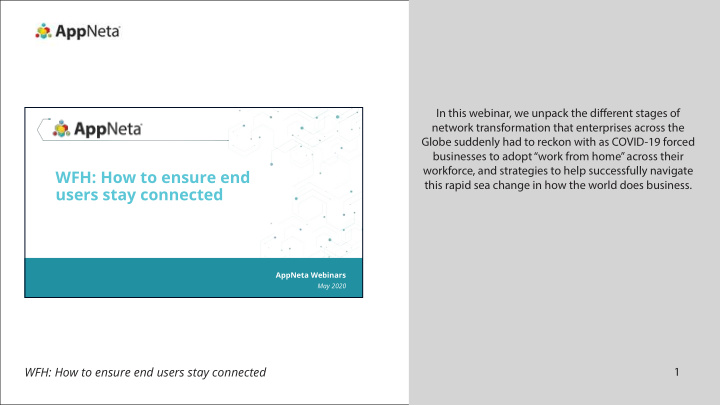



In this webinar, we unpack the di ff erent stages of network transformation that enterprises across the Globe suddenly had to reckon with as COVID-19 forced businesses to adopt “work from home” across their ����������������������� workforce, and strategies to help successfully navigate this rapid sea change in how the world does business. �������������������� ���������������� �������� WFH: How to ensure end users stay connected 1
A rapid switch to ‘work-from-home’ comes with it’s own unique set of challenges for ensuring that your critical applications, VPN, and business services are accessible and working well for remote users. ������������������������� � AppNeta's VP of Product Sean Armstrong and Principal ���������������������������� � Solutions Consultant John Tew fi k have been listening ������� � �������������� ������ to customers and understand the struggle intimately, � ������������������ and share here how you can tackle these key consider- � �������������������� ations and set your network management team up for ����������� � long-term success. WFH: How to ensure end users stay connected 2
John Tew fi k has over 15 years experience working with �������� networks, systems and at software companies. With a background in network technology and a passion for solving problems, he gets to do both every day at ���������� AppNeta. ������������������������������ ������������������ Sean Armstrong has been in product management at AppNeta for twelve years and in the industry for over twenty. As vice president of products, Sean revels in �������������� taking deep network information and making it inter- �������������������������� esting and digestible to businesses. ������������������� �������� WFH: How to ensure end users stay connected 3
Prior to COVID-19, assisting companies with network transformation was one of the major activities at AppNeta. Companies transitioning workloads to the cloud, deploying SD-WAN and DIA architectures, and �������������� ��������� adopting new UC services were the order of the day. ��������������� ����������� The vast majority of the time this was done from corpo- ��������� rate o ffi ces to a hybrid environment of data centers, �������� ����������� ��� �� �������� public cloud and SaaS services. ����������� ������������ ����������� ����������� �������� WFH: How to ensure end users stay connected 4
With COVID-19, the major change has not been where the apps are hosted, but rather how the users are accessing them, as employees are entering the network from their home o ffi ces, over their residential �������������� ��������� internet connections. In short, we’re hearing from companies that there are two key areas that require ��������������� ��������� monitoring: The workstations themselves, which many ��������� ��������� companies often have in place, and the application �������� ����������� ��� �� �������� delivery networks, which is a huge unknown to pretty much every customer in this WFH transition. ����������� ������������ ����������� ����������� �������� WFH: How to ensure end users stay connected 5
While we’ve been working with our customers to help ������������������ adapt their strategies, we’ve been observing that their e ff orts seem to align with 3 common stages. The fi rst stage is response mode, the next is about understand- ing performance of these new network architectures and getting to the bottom of what is causing ongoing degradation, while the third stage is really accepting that this is the new normal. ������� ������� ������� ����� ��������� ����������� ������������������� �������������������������� ���������������������� ���������� ���������������� �������������� �������� WFH: How to ensure end users stay connected 6
As your users have abruptly transitioned to WFH, �������������� you’ve likely beehave been challenged to solve prob- lems they have likely never considered before. The key ����������������������������� here is to triage the systematic problems, ensuring that key infrastructure and services are working properly for ���������������� ���������������������� � the majority of users, and then addressing one-o ff ������������������������������������� � issues as resources allow. A common refrain at this ��������������������������� � point is the mantra of “Grant me the serenity to control ��������������������������������� � the parts of the network that I can, and accept the ���������������������������������� � ������������������� � parts that I can’t...” but gaining that required visibility is ������������������� key to long term success. � ������������������ � �������� � ���������������� � �������� WFH: How to ensure end users stay connected 7
Critical in identifying these blind spots is that not all ������������������� applications will be accessed the same way. Most companies we work with are in some phase of transi- tion from internal and co-lo hosted applications to ���������������������� ������������������� ������������� ��������������� ��������������� Cloud and SaaS, and this dual nature means that both the DIA network paths, and VPN network paths need to ���������� be monitored. ���������������� ���������������� WFH: How to ensure end users stay connected 8
After you’ve done your best to “stop the bleeding” ������������������ associated with Stage 1, you need to start actually putting some resolutions in place that go above and �������������������������������������������������������� beyond “triage.” This includes deploying new technolo- gies and undergoing some thoughtful network rearchi- ������������������������������������������ tecting in critical areas to help make management ����������������������� easier now that the immediate network “ fi res” have � ���������������������������������������� � been put out. ����������������� � ������������������������������ � ���������������������� � ��������������������������� � ������������������������� � ���������������������������� � �������� WFH: How to ensure end users stay connected 9
Recommend
More recommend